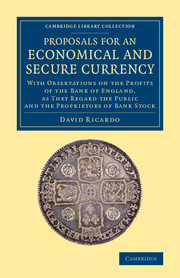Two Hundred Years of An Economical and Secure Currency (SOAS, London, 2-3 June 2016)
 Papers are invited for a conference to commemorate the bicentenary David Ricardo’s Proposals for an Economical and Secure Currency; with Observations on the Profits of the Bank of England, as they Regard the Public and the Proprietors of Bank Stock, published in 1816.
Papers are invited for a conference to commemorate the bicentenary David Ricardo’s Proposals for an Economical and Secure Currency; with Observations on the Profits of the Bank of England, as they Regard the Public and the Proprietors of Bank Stock, published in 1816.
The conference, sponsored by the Royal Economic Society, The Ricardo Society of Japan and the Money and Development Seminar, will be held at SOAS, University of London UK on the 2 and 3 June 2016 with a keynote address by David Laidler.
Further details about the conference and registration may be found in the call for papers, which is reproduced here below.
Call for papers
Ricardo’s monetary theory and policy
two hundred years after Proposals for an Economical and Secure Currency
London, 2-3 June 2016
The Scientific Committee, Ghislain Deleplace (University of Paris 8), Charles Goodhart (London School of Economics), David Laidler (University of Western Ontario), Maria Cristina Marcuzzo (University of Rome La Sapienza), Arturo O’Connell (Central Bank of Argentina), Susumu Takenaga (Daitobunka University, Tokyo) and Jan Toporowski (SOAS, University of London), invites contributions to a conference to be held at SOAS, University of London on the 2-3 June 2016, to commemorate the bicentenary of David Ricardo’s Proposals for an Economical and Secure Currency; with Observations on the Profits of the Bank of England, as they Regard the Public and the Proprietors of Bank Stock, published in 1816.
Organising Committee: Jan Toporowski (SOAS, University of London), Andrew Trigg (The Open University), Richard Van den Berg (Kingston University, London)
One-page (500 words) abstracts should be sent no later than 29 February 2016 to Andrew Trigg, at A.B.Trigg@open.ac.uk
Notification of decision will be made on 15 March 2016 and the full paper should be available no later than 15 May 2016.
The conference is sponsored and supported by the Royal Economic Society, the Ricardo Society of Japan, and the Money and Development Seminar of SOAS, University of London. The conference will include a keynote address by Professor David Laidler, a conference dinner, a reception at Keynes’ house in Gordon Square and visits to places associated with David Ricardo.
Proposals for an Economical and Secure Currency, published in 1816, provides the link between Ricardo’s first monetary essays at the time of the Bullion Report, which made him known as an economist, and his plan for the resumption of note convertibility, which was adopted by Parliament in 1819. Enlarging a suggestion he had made in the fourth (1811) edition of his famous The High Price of Bullion, a Proof of the Depreciation of Bank Notes, Ricardo introduced two main novelties for Bank of England notes: they were to be convertible into bullion instead of coin, and their quantity issued was to vary inversely with the sign of the spread between the market price of gold bullion and the legal price at which it could be obtained (against notes) at the Bank. The object of this “Ingot Plan” was to substitute convertible notes for specie – in short to demonetise gold in domestic circulation. As James Bonar would put it one century later, this “complete Plan was to be the euthanasia of metal currency.” Ricardo was so confident in his ideas that he quoted four full pages of Proposals in the second and third editions of On Principles of Political Economy, and Taxation, in an attempt to put the case for his plan in Parliament – with success in 1819, although temporarily: convertibility into coin was resumed in 1821 and no guideline for the issuing of notes was henceforth imposed on the Bank of England.
Ricardo’s Proposals had afterwards to wait until the twentieth century to get recognition. In the nineteenth century, the Bank Charter Act of 1844 turned its back to them, by maintaining convertibility into coin and adopting a 100 per cent metallic backing as rule for the additional note issuing. The “Ingot Plan” was only revived in the 1880s by Alfred Marshall in the debate on bimetallism and in the 1890s by Alexander Lindsay in the context of reform of the monetary system in India. The latter connexion led John Maynard Keynes to praise it highly in Indian Currency and Finance in 1913 and to acknowledge that Ricardo had been the first to theorise the gold-exchange standard, by separating domestic circulation (exclusively of notes convertible into bullion) and foreign payments (in bullion). In Britain, it took more than a century to at last validate the ingot proposal when after WWI convertibility was resumed in 1925, without, however, breaking with the 1844 Bank Charter Act.
Contrasting the received association of Ricardo with monetary orthodoxy, Proposals thus convey an image of him far ahead of his time, with innovative solutions to guarantee the security of the currency, as emphasised in their title. This pamphlet focused on an issue which the present crisis has brought back to the top of the economic agenda: the appropriate design of a resilient monetary system. On the occasion of the bicentenary of its publication, papers submitted to the conference are invited to examine various aspects of Ricardo’s ideas and recommendations related to issues raised in Proposals, including the links to his other writings and to modern monetary theory and policy.
